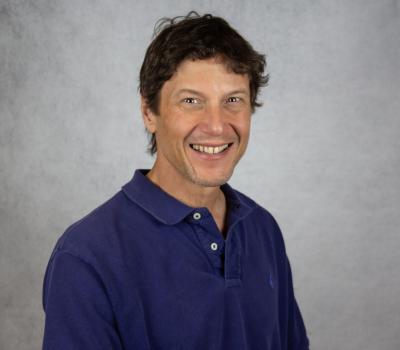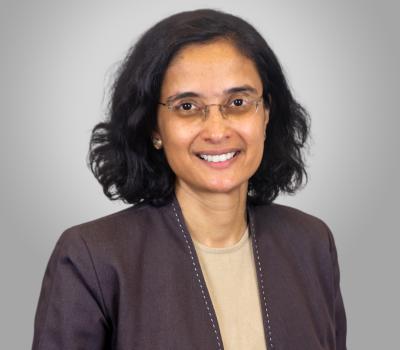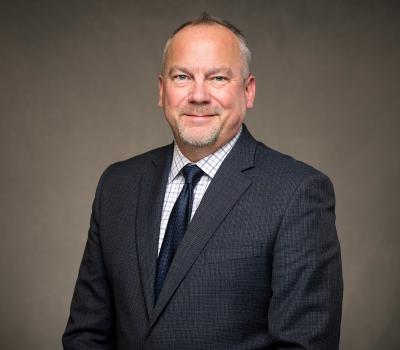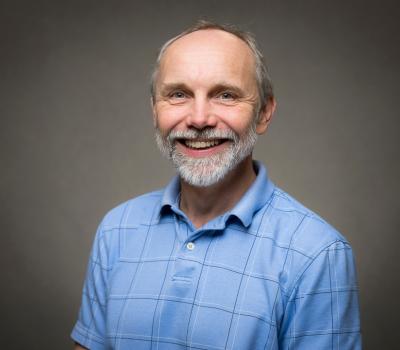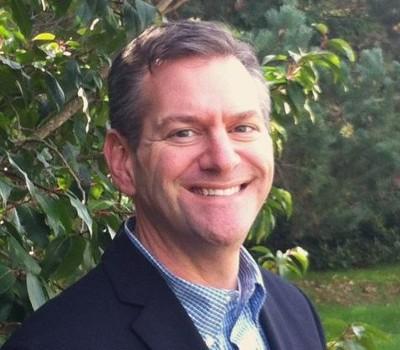Líney Árnadóttir’s research group primarily uses computational methods to study chemical processes on surfaces with applications in renewable energy and material degradation. Kinetic modeling and density functional theory are the main computational approaches used to gain atomistic insights into these processes. The group frequently collaborates with experimental groups and uses experimental surface science tools to complement their computational methods.
David P. Cann received a B.S. degree in Materials Engineering from the Virginia Polytechnic and State University in Blacksburg, VA in 1991. He received M.S. and Ph.D. degrees in Materials from the Pennsylvania State University in 1993 and 1997, respectively. In 1997, he joined the Materials Science and Engineering faculty at Iowa State University, in Ames, IA.
In 2005, he joined Oregon State University, where he is now an Professor of Materials Science. His research is focused on the area of ferroelectric, dielectric, and semiconducting ceramic materials with funding from the National Science Foundation, the Office of Naval Research, NASA, the Department of Energy, and industrial sources. He has made notable research contributions in (i) the development of piezoelectric and dielectric materials based on perovskite and pyrochlore structures, (ii) the crystal chemistry of transparent conducting oxides for optoelectronic applications, (iii) the study of interactions between ferroelectric materials and their electrodes, and (iv) metal oxide-based chemical sensors. Dr. Cann is a recipient of the CAREER award from the National Science Foundation (2001).
Dr. Cann is the author or co-author of over 80 publications in peer reviewed journals and holds one patent. He is also an Editor for the Journal of Materials Science, overseeing the electronic ceramics technical area. He is a Senior Member of IEEE and serves as the VP for Ferroelectrics within the IEEE Ultrasonics, Ferroelectrics, and Frequency Control Society.
John F. Conley, Jr. received a B.S. in Electrical Engineering in 1991 and a Ph.D. in Engineering Science and Mechanics in 1995 from The Pennsylvania State University, where he won a 1996 Xerox Prize for his Ph.D. dissertation. He was with Dynamics Research Corporation from 1995 to 2000 and with the Jet Propulsion Laboratory from 2000-2001, where he received an achievement award. From 2001-2007 he was with Sharp Laboratories of America where he last was Leader of the Novel Materials and Devices Group. In 2002-03, he served as an adjunct professor at the Vancouver campus of Washington State University. Since 2007, he has been a Professor and an ONAMI Signature Faculty Fellow at Oregon State University in both the School of Electrical Engineering and Computer Science and the Intercollege Materials Science Program.
He has authored or co-authored over 100 technical papers (including several invited) and over 140 conference presentations. He is the holder of nineteen U.S. patents. He has presented tutorial short courses on high-k dielectrics at two international conferences. He has served on the technical and management committees of several international conferences, including General Chair of the 2006 IEEE International Integrated Reliability Workshop. He has also served several times as a guest editor of IEEE Transactions on Device and Materials Reliability. He is a reviewer for the National Science Foundation and many other programs and journals.
Dr. Conley’s current research interests include atomic layer deposition, metal/insulator/metal devices (MIM high-κ capacitors, MIM & MIIM tunnel diodes, and RRAM / memristors), internal photoemission, thin film transistors, electron spin resonance (ESR) identification of point defects that play a role in reliability and radiation induced instabilities in novel electronic materials, and directed integration of nanomaterials and devices.
Pallavi Dhagat holds a doctoral degree from Washington University, St. Louis, where her research focused on the characterization of thermal reversal of magnetic grains. She has an extensive background in magnetic recording technology as a recording physicist.
Prior to joining OSU as an assistant professor, she was a research engineer in the Advanced Concepts Group at Seagate Technology, Minneapolis. Here she made significant contribution to the development of perpendicular recording technology.
Her research interests include information storage, magnetization dynamics, magnetic nano-metrology, bio-magnetic sensors and distributed sensor systems.
Prof. Gibbons specializes in structure-process-property relationships in multifunctional thin film materials. His group focuses on thin film processing, novel instrumentation development, and integration science; new dielectric, superconducting, semiconducting, and pyroelectric materials for energy conversion and energy storage; ferroelectric and piezoelectric thin films for microelectromechanical systems; scanning probe and x-ray diffraction characterization methods; and spectroscopic ellipsometry. Specifically he is interested in developing novel integration science strategies to combine material functionalities that result in significantly enhanced, or even new, properties.
Prior to arriving at OSU in 2006 he spent eight years at Los Alamos National Laboratory as a postdoctoral researcher and member of the technical staff. There, his research on 2nd generation superconducting wire led to an R&D 100 Award in 2004. He is an NSF CAREER award recipient, and is active in both the IEEE UFFC and the American Ceramic Society. He received his M.S. in Ceramic Science in 1995 and his Ph. D. in Materials in 1998, both from the Pennsylvania State University.
Dr. Jander received his Masters and Ph.D. degrees from Washington University in St. Louis. He co-directs the Applied Magnetics Laboratory with Pallavi Dhagat, where they are pushing the boundaries of what can be done with magnetics. Jander says they focus on areas of magnetics that few others are working on and where they can make their mark in doing innovative advanced work.
Douglas A. Keszler, Distinguished Professor of Chemistry, received a B.S. degree in Chemistry from Southwestern Oklahoma State University in 1979 and Ph.D. in Chemistry from Northwestern University in 1984. He spent a year as a postdoctoral associate at Cornell University prior to beginning his career at OSU in 1985.
His research interests encompass the synthesis and study of inorganic materials via both solution-based and conventional solid-state techniques. His group has made seminal contributions in areas including phosphors, nonlinear optical crystals, transparent electronics, printed electronics, solar absorbers, inverse design, and inorganic resists. He is currently the Director of the Center for Sustainable Materials Chemistry, a $20M Phase-II Center for Chemical Innovation funded by the National Science Foundation and the Oregon Nanoscience and Microtechnologies Institute. He is active in promoting student education and network building activities that support the innovation process.
Yun-Shik Lee received his B.S. in Chemistry and M.S. in Physics at Seoul National University in 1989 and 1991, respectively. He earned his Ph.D. in Physics at University of Texas at Austin in 1997. From 1997 to 2010 he was at the Center for Ultrafast Optical Science in University of Michigan severing as a research scientist, where he worked on quantum carrier dynamics in semiconductor nanostructures and developed novel techniques of terahertz (THz) pulse generation.
He joined OSU in 2001 and is current an Associate Professor at the Department of Physics. He received the NSF CAREER award in 2005. He is a leading expert on THz spectroscopy of nanoscale material systems, and the author of a book entitled “Principles of Terahertz Science and Technology” published by Springer in 2009. His research group have involved in the development of THz manipulation techniques, THz quantum carrier dynamics in semiconductor nanostructures, and THz imaging and spectroscopy of carbon nanostructures. His current research interests include quantum control of wave packets in semiconductors, nonlinear interactions of THz radiation with graphene and carbon nanotubes, THz spectroscopy of tunneling devices, and subwavelength THz imaging with plasmonic devices
Mike Lerner received his B.S. degree from the University of Pennsylvania in 1983, and a Ph.D. at the University of CA, Berkeley in 1988. He was an NSF Postdoctoral Fellow at Northwestern University and Lawrence Berkeley Labs from 1988-1990, and joined the OSU in 1990 where he is now a Professor of Chemistry. Dr. Lerner has also been a visiting professor in Japan, a Fulbright Fellow, and an Intel employee. His research interests include battery chemistry, intercalation compounds, and nanocomposites. He has over 80 peer-reviewed publications in materials chemistry and has written several reviews in the field of intercalation and nanocomposite chemistry. Dr. Lerner is also director of the online education program in chemistry, with an active interest in adapting science education to new learning technologies.
David H. McIntyre is a Professor of Physics at Oregon State University. He obtained his B.S. degree from the University of Arizona (1980) and M.S. and Ph.D. degrees from Stanford University (1984, 1987). He worked at the Max Planck Institute for Quantum Optics before coming to Oregon State University in 1989. His research interests are in laser spectroscopy and optical physics. His current projects include optical trapping of particles with laser tweezers and optical characterization of wide bandgap semiconductors.
Ethan D. Minot received his PhD in physics from Cornell University in 2004. He completed postdoctoral work at Delft University of Technology (2005 and 2006) before joining the physics faculty at Oregon State University in 2007. Dr Minot's research focuses on the electronic and optical properties of carbon nanotubes (CNTs) and graphene. His lab grows large-area films of CNTs and graphene using custom-built chemical vapor deposition furnaces. These nanomaterials are processed to create devices such as CNT field-effect transistors. Dr. Minot's current research interests include the use of carbon nanotube circuits to detect single enzyme dynamics, and the efficiency of the photocurrent generation process in CNT pn junctions.
Vince Remcho is Professor of Chemistry and Professor of Materials Science at Oregon State University (OSU). He also holds adjunct appointments in Biochemistry & Biophysics and Industrial & Manufacturing Engineering. His research group focuses on the design, fabrication and optimization of microfluidic analytical instruments and microreactors, and the application of these systems in biochemical, environmental, and nanomanufacturing problem solving. The work is highly interdisciplinary and collaborative: the group enjoys research partnerships with friends in the physical-, life-, and earth sciences and engineering. Financial support for this research has come from the NIH (SRP program), DOE, NSF, the Air Force Research Laboratories, the Army Research Laboratory, the Office of Naval Research, private industry, the W.M. Keck Foundation and the Murdock Charitable Trust. Prof. Remcho has been recognized for research excellence by the NSF through a CAREER Award and the 2010 Milton Harris Award in Basic Research, and for teaching excellence via a College of Arts and Sciences Outstanding Teaching Award. He is a founding member of the Oregon Nanoscience and Microtechnologies Institute (ONAMI), is past chair of the Oregon Section of the American Chemical Society (ACS), and has served as advisor to the ACS Student Affiliates, which provides free chemistry demonstrations in local schools. He has authored ten book chapters and more than 60 technical papers in the last ten years, and has presented over 50 invited lectures at Universities in the US and abroad and at national and international scientific meetings in that same period. Prof. Remcho is Associate Dean for Research in the College of Science at OSU.
Professor Mas Subramanian received his Ph.D. degree (Materials Chemistry) in 1982 from Indian Institute of Technology, Madras, India. After spending 2 years as a postdoctoral fellow at Texas A&M University, he joined Central Research and Development Department of DuPont Company (USA) as a research chemist and was promoted to Research Fellow in 2003. In 2006, he joined the Department of Chemistry, Oregon State University, USA as a Milton-Harris Endowed Professor of Materials Science.
Professor Subramanian is an internationally recognized scientist for his pioneering work in the area of Materials Chemistry. He is credited with discovery of several novel functional materials in the area of electronics (superconductors, dielectrics), energy conversion (thermoelectrics, solid state batteries), green chemistry (zero waste catalysts), and recently in the area of color pigments. He has authored 300+ publications and listed as inventor in 54 issued US patents. His publications have been cited 13,000+ times with an h-index of 52. He is the editor of two international journals (Solid State Sciences and Progress in Solid State Chemistry) and a member of the editorial board in several other journals in Materials area. He has received several awards and honors including 2004 DuPont Charles Pedersen Medal (named after DuPont Nobel Laureate) for Excellence in Scientific and Technical Achievement and 2012 Chemical Research Society of India Medal of Excellence. He currently holds the Milton Harris endowed chair of materials science.
Janet Tate received her Ph.D. in Physics from Stanford University in 1988, following her B.Sc. in Physics and Chemistry in 1981 and B.Sc.(Hons) in Physics in 1982 from the University of Natal (South Africa). From 1987-1989, she was a Humboldt post-doctoral scholar at the Technical University of Munich, where she worked on high-temperature superconductors. She joined the OSU faculty in 1989, and is currently Professor of Physics. Her research area is transport, optical, and structural properties of thin-film electronic materials, and her lab has several physical vapor deposition systems, including pulsed laser deposition. Her current focus is novel wide-gap semiconductors and nanolaminates, with applications in photovoltaics, thermoelectrics and transparent electronics. She and her students collaborate with groups in Physics, Chemistry, Engineering and Materials Science.
John F. Wager received the B.S. degree in Engineering Physics from Oregon State University in 1977 and the M.S. and Ph.D. degrees in Electrical Engineering from Colorado State University in 1978 and 1981, respectively. From 1982-1984 he worked at Hughes Research Laboratories where he was involved in the development of compound semiconductor devices for high-speed and optoelectronic applications. He joined the Department of Electrical and Computer Engineering at Oregon State University in 1984, and he currently holds the Michael and Judith Gaulke Endowed Chair in the School of EECS. He is lead author of a book entitled “Transparent Electronics.” Transparent electronics technology developed in his group at OSU was licensed to Hewlett-Packard Company who has continued advanced joint-development with his group. This technology is finding emerging, high-value applications in flat-panel display thin-film transistor backplanes. His current research interests include transparent electronics, oxide electronics, printed electronics, metal-insulator tunneling electronics, and thin-film photovoltaics.


